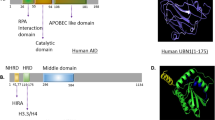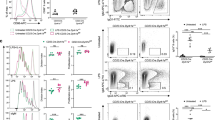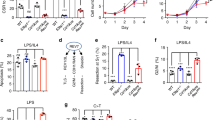Abstract
Activation-induced cytidine deaminase (AID) is the essential and sole B cell–specific factor required for class-switch recombination (CSR) and somatic hypermutation (SHM). However, it is not known how AID differentially regulates these two independent events. Involvement of several cofactors interacting with AID has been indicated by scattered distribution of loss-of-function point mutations and evolutionary conservation of the entire 198-amino-acid protein. Here, we report that human AID mutant proteins with insertions, replacements or truncations in the C-terminal region retained strong SHM activity but almost completely lost CSR activity. These results indicate that AID requires interaction with a cofactor(s) specific to CSR.
This is a preview of subscription content, access via your institution
Access options
Subscribe to this journal
Receive 12 print issues and online access
$209.00 per year
only $17.42 per issue
Buy this article
- Purchase on Springer Link
- Instant access to full article PDF
Prices may be subject to local taxes which are calculated during checkout



Similar content being viewed by others
References
Honjo, T., Kinoshita, K. & Muramatsu, M. Molecular mechanism of class switch recombination: linkage with somatic hypermutation. Annu. Rev. Immunol. 20, 165–196 (2002).
Kinoshita, K. & Honjo, T. Linking class-switch recombination with somatic hypermutation. Nat. Rev. Mol. Cell Biol. 2, 493–503 (2001).
Reynaud, C.A., Aoufouchi, S., Faili, A. & Weill, J.C. What role for AID: mutator, or assembler of the immunoglobulin mutasome? Nat. Immunol. 4, 631–638 (2003).
Muramatsu, M. et al. Specific expression of activation-induced cytidine deaminase (AID), a novel member of the RNA-editing deaminase family in germinal center B cells. J. Biol. Chem. 274, 18470–18476 (1999).
Muramatsu, M. et al. Class switch recombination and hypermutation require activation-induced cytidine deaminase (AID), a potential RNA editing enzyme. Cell 102, 553–563 (2000).
Revy, P. et al. Activation-induced cytidine deaminase (AID) deficiency causes the autosomal recessive form of the Hyper-IgM syndrome (HIGM2). Cell 201, 565–575 (2000).
Okazaki, I.M., Kinoshita, K., Muramatsu, M., Yoshikawa, K. & Honjo, T. The AID enzyme induces class switch recombination in fibroblasts. Nature 416, 340–345 (2002).
Yoshikawa, K. et al. AID is a hypermutator of actively-transcribed genes in fibroblasts. Science 296, 2033–2036 (2002).
Arakawa, H., Hauschild, J. & Buerstedde, J.M. Requirement of the activation-induced deaminase (AID) gene for immunoglobulin gene conversion. Science 295, 1301–1306 (2002).
Harris, R.S., Sale, J.E., Petersen-Mahrt, S.K. & Neuberger, M.S. AID is essential for immunoglobulin V gene conversion in a cultured B cell line. Curr. Biol. 12, 435–438 (2002).
Muto, T., Muramatsu, M., Taniwaki, M., Kinoshita, K. & Honjo, T. Isolation, tissue distribution, and chromosomal localization of the human activation-induced cytidine deaminase (AID) gene. Genomics 68, 85–88 (2000).
Doi, T., Kinoshita, K., Ikegawa, M., Muramatsu, M. & Honjo, T. De novo protein synthesis is required for the activation-induced cytidine deaminase function in class-switch recombination. Proc. Natl. Acad. Sci. USA 100, 2634–2638 (2003).
Petersen-Mahrt, S.K., Harris, R.S. & Neuberger, M.S. AID mutates E. coli suggesting a DNA deamination mechanism for antibody diversification. Nature 418, 99–103 (2002).
Ramiro, A.R., Stavropoulos, P., Jankovic, M. & Nussenzweig, M.C. Transcription enhances AID-mediated cytidine deamination by exposing single-stranded DNA on the nontemplate strand. Nat. Immunol. 4, 452–456 (2003).
Dickerson, S.K., Market, E., Besmer, E. & Papavasiliou, F.N. AID mediates hypermutation by deaminating single stranded DNA. J. Exp. Med. 197, 1291–1296 (2003).
Chaudhuri, J. et al. Transcription-targeted DNA deamination by the AID antibody diversification enzyme. Nature 422, 726–730 (2003).
Bransteitter, R., Pham, P., Scharff. M.D. & Goodman, M.F. Activation-induced cytidine deaminase deaminates deoxycytidine on single-stranded DNA but requires the action of RNase. Proc. Natl. Acad. Sci. USA 100, 4102–4107 (2003).
Di Noia, J. & Neuberger, M.S. Altering the pathway of immunoglobulin hypermutation by inhibiting uracil-DNA glycosylate. Nature 419, 43–48 (2002).
Rada, C. et al. Immunoglobulin isotype switching in inhibited and somatic hypermutation perturbed in UNG-deficient mice. Curr. Biol. 12, 1748–1755 (2002).
Azuma, T., Motoyama, N., Fields, L.E. & Loh, D.Y. Mutations of the chloramphenicol acetyl transferase transgene driven by the immunoglobulin promoter and intron enhancer. Int. Immunol. 5, 121–130 (1993).
Yelamos, J. et al. Targeting of non-Ig sequences in place of the V segment by somatic hypermutation. Nature 376, 225–229 (1995).
Kinoshita, K., Tashiro, J., Tomita, S., Lee, C.G. & Honjo, T. Target specificity of immunoglobulin class switch recombination is not determined by nucleotide sequences of S regions. Immunity 9, 849–858 (1998).
Tashiro, J., Kinoshita, K. & Honjo, T. Palindromic but not G-rich sequences are targets of class switch recombination. Int. Immunol. 13, 495–505 (2001).
Shinkura, R. et al. The influence of transcriptional orientation on endogenous switch region function. Nat. Immunol. 4, 435–441 (2003).
Reaban, M.E., Lebowitz, J. & Griffin, J.A. Transcription induces the formation of a stable RNA.DNA hybrid in the immunoglobulin α switch region. J. Biol. Chem. 269, 21850–21857 (1994).
Mussmann, R., Courtet, M., Schwager, J. & Du Pasquier, L. Microsites for immunoglobulin switch recombination beakpoints from Xenopus to mammals. Eur. J. Immunol. 27, 1610–1619 (1997).
Tian, M. & Alt, F.W. Transcription-induced cleavage of immunoglobulin switch regions by nucleotide excision repair nucleases in vitro. J. Biol. Chem. 275, 24163–24172 (2000).
Mizuta, R. et al. Molecular visualization of immunoglobulin switch region RNA/DNA complex by atomic force microscope. J. Biol. Chem. 278, 4431–4434 (2003).
Yu, K., Chedin, F., Hsieh, C-L., Wilson, T.E. & Lieber, M.R. R-loops at immunoglobulin class switch regions in the chromosomes of stimulated B cells. Nat. Immunol. 4, 442–451 (2003).
Faili, A. et al. AID-dependent somatic hypermutation occurs as a DNA single-strand event in the BL2 cell line. Nat. Immunol. 3, 815–821 (2002).
Peterson, S. et al. AID is required to initiate Nbs1/γ-H2AX focus formation and mutations at sites of class switching. Nature 414, 660–665 (2001).
Chen, X., Kinoshita, K. & Honjo, T. Variable deletion and duplication at recombination junction ends: implication for staggered double-strand cleavage in class-switch recombination. Proc. Natl. Acad. Sci. USA 98, 13860–13865 (2001).
Minegishi, Y. et al. Mutations in activation-induced cytidine deaminase in patients with hyper IgM syndrome. Clin. Immunol. 97, 203–201 (2000).
Zhu, Y. et al. Type two hyper-IgM syndrome caused by mutation in activation-induced cytidine deaminase. J. Med. Dent. Sci. 50, 41–46 (2003).
Navaratnam, N. et al. Escherichia coli cytidine deaminase provides a molecular model for Apo RNA editing and a mechanism for RNA substrate recognition. J. Mol. Biol. 275, 695–714 (1998).
Fagarasan, S., Kinoshita, K., Muramatsu, M., Ikuta, K. & Honjo, T. In situ class switching and differentiation to IgA-producing cells in the gut lamina propria. Nature 413, 639–643 (2001).
Kinoshita, K., Harigai, M., Fagarasan, S., Muramatsu, M. & Honjo, T. A hallmark of active class switch recombination: Transcript directed by I promoters on looped-out circular DNAs. Proc. Natl. Acad. Sci. USA 98, 12620–12633 (2001).
Martin, A. et al. Activation-induced cytidine deaminase turns on somatic hypermutation in hybridomas. Nature 415, 802–806 (2002).
Flajnick, M.F. Comparative analyses of immunoglobulin genes: surprise and portents. Nature Rev. Imuunol. 2, 688–698 (2002).
Mehta, A., Kinter, M.T., Sherman, N.E. & Driscoll, D.M. Molecular cloning of apobec-1 complementation factor, a novel RNA-binding protein involved in the editing of apolipoprotein B mRNA. Mol. Cell. Biol. 20, 1846–1854 (2000).
Henderson, J.O., Blanc, V. & Davidson N.O. Isolation, characterization and developmental regulation of the human apobec-1 complementation factor (ACF) gene. Biochim. Biophys. Acta 1522, 22–30 (2001).
Harris, R.S., Petersen-Mahrt, S.K. & Neuberger, M.S. RNA editing enzyme APOBEC1 and some of its homologs can act as DNA mutators. Mol. Cell 10, 1247–1253 (2002).
Pham, P., Bransteitter, R., Petruska, J. & Goodman, M.F. Processive AID-catalysed cytosine deamination on single-stranded DNA simulates somatic hypermutation. Nature 424, 103–107 (2003).
Maas, S., Rich, A. Changing genetic information through RNA editing. Bioessays 22, 790–802 (2000).
Gallo, A., Keegan, L.P., Ring, G.M. & O'Connell, M.A. An ADAR that edits transcripts encoding ion channel subunits functions as a dimer. EMBO J. 22, 3421–3430 (2003).
Cho, D.S, Yang, W., Lee, J.T., Shiekhattar, R., Murray, J.M. & Nishikura, K. Requirement of dimerization for RNA editing activity of adenosine deaminases acting on RNA. J. Biol. Chem. 278, 17093–17102 (2003).
Sowden, M.P. et al. The editosome for cytidine to uridine mRNA editing has a native complexity of 27S: identification of intracellular domains containing active and inactive editing factors. J. Cell Sci. 115, 1027–1039 (2002).
Acknowledgements
We thank M. Nakata, T. Toyoshima and E. Inoue for technical support; T. Nishikawa and Y. Shiraki for help in preparing the manuscript; S. Fagarasan, B. Meek and R. Shinkura for critical reading of the manuscript; and P. Lane for clinical support of patients. This investigation was supported by The Japan Society for the Promotion of Science (to V.-T.T.) and Center-of-Excellence grants from Minister of Education, Culture, Sports, Science and Technology.
Author information
Authors and Affiliations
Corresponding author
Ethics declarations
Competing interests
The authors declare no competing financial interests.
Rights and permissions
About this article
Cite this article
Ta, VT., Nagaoka, H., Catalan, N. et al. AID mutant analyses indicate requirement for class-switch-specific cofactors. Nat Immunol 4, 843–848 (2003). https://doi.org/10.1038/ni964
Received:
Accepted:
Published:
Issue Date:
DOI: https://doi.org/10.1038/ni964
This article is cited by
-
A Novel Heterozygous Variant in AICDA Impairs Ig Class Switching and Somatic Hypermutation in Human B Cells and is Associated with Autosomal Dominant HIGM2 Syndrome
Journal of Clinical Immunology (2024)
-
A Novel AICDA Splice-Site Mutation in Two Siblings with HIGM2 Permits Somatic Hypermutation but Abrogates Mutational Targeting
Journal of Clinical Immunology (2022)
-
Activation-induced deaminase and its splice variants associate with trisomy 12 in chronic lymphocytic leukemia
Annals of Hematology (2019)
-
Diversity of Immunoglobulin (Ig) Isotypes and the Role of Activation-Induced Cytidine Deaminase (AID) in Fish
Molecular Biotechnology (2018)
-
Activation-induced cytidine deaminase targets SUV4-20-mediated histone H4K20 trimethylation to class-switch recombination sites
Scientific Reports (2017)



